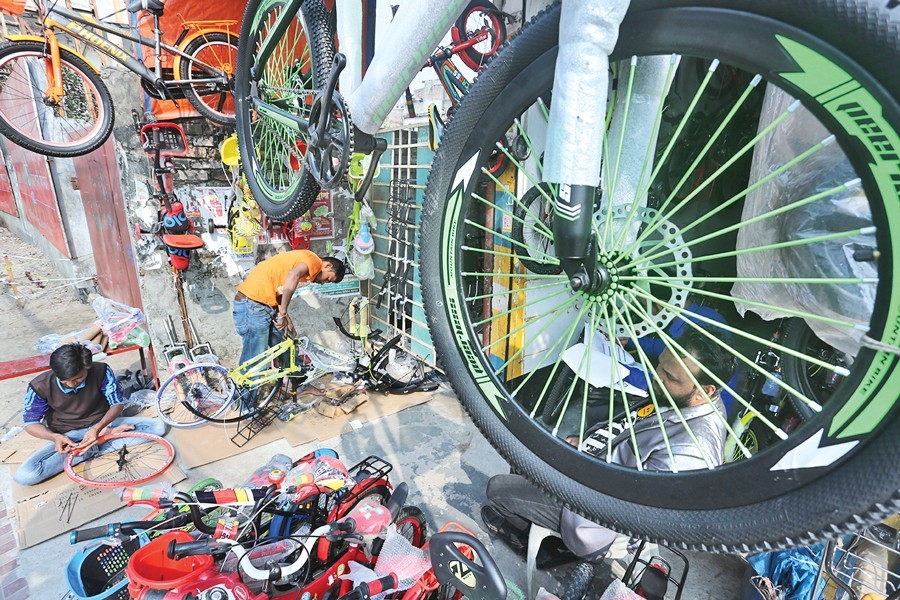Export of bicycles from the country is up. Manufacturers registered 58 per cent export growth year-on-year to $130 million in fiscal 2020-21, according to the Export Promotion Bureau (EPB) data. Given of course the small base, the growth may not look like a major achievement. What, however, is important in this regard is the quick entry of Bangladesh-made bicycles into the developed markets. Although manufacturing the two wheelers began in the country sometime ago, the purpose was ostensibly to cater to domestic market-- that too only partly.
Within years, the production line has expanded with more entrepreneurs including a foreign venture joining the industry, and exporting has figured as a key objective. Against this backdrop, the growth of export is no mean accomplishment, for sure.
The European Union's statistical wing, Eurostat, furnished a comprehensive picture of the expansion of Bangladesh's bicycle export to the European markets. It says, Bangladesh has struck a major breakthrough in exports to the European markets since 2010. It was in that year that Bangladesh's export of bicycles to Europe, measured in terms of ranking, rose to fifth position from tenth in the preceding year. The ranking has substantially improved in the following years as, according to Eurostat, in 2017, Bangladesh became the third-largest exporter of bicycles to the UK and the EU.
The current growth is attributed to people's preference for the environment friendly, social distance-friendly two wheelers -- a safer mode of commuting instead of using public transport. Clearly, covid-19 has had a positive impact on overseas marketing. And since market access has been successfully done, industry insiders are hopeful of expanding and diversifying their range in export, particularly to the European markets. At present, eight companies in the country export bicycles, two of which are in the Chattagram Export Processing Zone (CEPZ). Besides, there are bicycle manufacturing companies in Dhaka, Gazipur, and Sylhet. Malaysian company Alita (BD) pioneered bicycle exports from Chittogram back in 1995 with the export of 37,000 bicycles to the UK. Soon other manufacturers followed suit. About 30 to 40 per cent of the raw materials for making these bicycles come from China, India, Malaysia, Indonesia, and Vietnam.
With exports growing, it is also encouraging for the industry to see a boom in local market. Bicycle riders have been increasing in the country, to the extent that surge in bicycles sales in local markets tends to suggest the growth trend as highly promising, coupled with the potential of expansion in bicycle manufacturing. The market is fast growing, and the share of locally produced bicycle is increasing. According to information made available by the bicycle merchants' association, presently there are more than 200 retail bicycle outlets in the country.
Although the number of manufacturing plants in the country is only a few, the growing demand and trends in increased sales have motivated the plant owners to plan their production targets at much higher levels than they had been doing in the past years. To meet the increasing demands, new entrepreneurs are also set to go for bicycle manufacturing in a big way to cater to both domestic and overseas markets.
It has been learnt from reports that over the recent years there has been an increase of 30-40 per cent in local sales, and annual consumption is estimated at half a million pieces. A major segment of the high and middle-end bicycles is import-dependent. A number of reputed manufacturing groups have been producing quality bicycles for local markets as well as for exports to some target markets in Europe.
Prospects of exporting are a great stimulus for the manufacturers who, it has been learnt, are quite upbeat about a remarkably increased share in global bicycle exports. Concerned quarters are of the opinion that due to discrepancies in the duty structure of spares and imported bicycles, the manufacturing sector is not getting the right boost it deserves in the wake of the increased demand both at home and abroad.
With the rise in exports coupled with growing domestic demand, further expansion of this prospective sector needs to be planned in a sustainable way. Facilitating the sector by way of support in production and marketing, harmonsing the duty structure, and necessary fiscal incentives need to be firmed up in consultation with the stakeholders. It has been learnt that the manufacturers have already asked for some facilitations from the government in terms of fiscal and financial incentives.
In a very recent move, the government has decided to provide 4.0 per cent cash incentive for bicycle export which, no doubt, is inspiring. However, beyond cash assistance, it is planning that matters most.
Given the country's emerging manufacturing base supported by semi-skilled and skilled workforce in the sector, it is expected that this nascent industry would be able to perform better with well planned facilitating measures.


